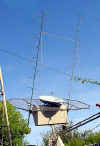|
Satellite Activities
I obtained my Amateur Radio License in 1960 and was given the call sign VK5ZAI. Shortly after building my first 2 metre transmitter and receiver I became interested in satellite communications.
The first satellite that I became involved with was OSCAR-3 which was launched on the 9th March 1965. It created a lot of excitement at the time amongst Hams and sent out "HI" in Morse, quite a simple device compared to today's standards. Back then we had to calculate the orbit passes with a pen and paper, no computers, not even a 4 function calculator but we managed.
The antenna I used to track it with was a twin Helix turned manually, a rather crude arrangement but it worked. Since then over the years I have been involved with many satellites, both voice and digital.
In the early 1990's I got into manned space flight speaking with the crews on the Mir Space Station and the Space shuttles on many occasions, I also did 2 school linkups with the Mir Space Station and setup the phone patch for Andy Thomas during his 4 months on Mir so he could speak to his family when over Australia.
In Nov. 2000 I was invited to join the ARISS telebridge team (Amateur Radio on International Space Station). This team consists of nine amateur radio stations around the world set up to support crew members wishing to speak to their family members during the mission, 3rd. party issues, or technical concerns, as well as making possible educational school contacts with the ISS. through Amateur Radio on board.
A general view of the satellite station, showing satellite tracking computer running Instant Track on the left, Transceivers, Automated Antenna Control and Phone Patch Interface in center of desk, WiNRADiO Receiver Computer on right of desk with Digital TMC's and backup Transceivers above. To the right of the operating desk is a rack which houses recording equipment, Antenna Patch Panel, Linear Amp, Packet Computer and Power Supplies. |

